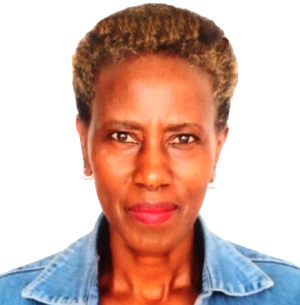Everything that Mildred Kaguhia Makaya had planned was derailed once the first coronavirus case was identified in Kenya.
So, the irony is not lost on her that she has benefitted from some really amazing opportunities during the COVID-19 pandemic period and feels that her career is already taking shape although she’s still a student.
She had lined up an internship doing a radio show on the United States International University (USIU) Radio and then all those plans fell apart. ‘The coronavirus hit at a time when I was just planning to get into the field and start practising real journalism,’ says Mildred, a third year student at the USIU in Nairobi. The university closed and students were sent home.

‘It threw me off course completely and I had to regroup and rethink.’ Not for long. A
position opened up at a printing press where they were overwhelmed by production and printing of fliers and materials related to the pandemic.
Five months later an opening for an intern at the Association of Media Women in Kenya (AMWIK) pulled Mildred into the civic space where she had a crash course in the concerns affecting women in the media during the pandemic. ‘Normally I just hear about these things in passing,’ she says. ‘I got to meet women and to hear first-hand experiences. I got to understand what is being done about uplifting the capacity and status of women journalists and to bridge the gap between men and women in the media sphere.’
As the association responded with small grants to 100 women to cover COVID-19, jobs lists and online support groups for peer education, marketing their side hustles and training; Mildred came to realise that the struggles of women in the media and in other spaces are actually a very big deal. She was perturbed by the constant chorus of concern about violence against women in the media – both offline and online – and the expectation that job losses as a result of COVID-19 would undo a lot of the progress that’s been made to grow the number of women in the media. That was the last thing a budding journalist needed to hear.
Mildred eventually resumed classes online but in the confusion of students leaving the campus – some travelling upcountry and some facing the reality that family incomes had evaporated with the pandemic – many of Mildred’s classmates took a semester break and some have yet to return.
Moving classes online has freed up a lot of her time and allows her to start the ground work for her career during the pandemic. ‘If we were still in school I wouldn’t have been able to take up the position at AMWIK where I’ve been learning a lot. I’ve also done a lot of writing at AMWIK.’
This sense of a mixed season for media women living through the COVID-19 pandemic holds also for Faith Oneya, an Editor with Nation Media Group, who now works from home most days.

‘It really saves so much commuting time and the stress of being in traffic,’ says Faith.
The shift to remote working mediated through digital technology has been an immersion in what is possible with digital technology making women experts on digital platforms that they didn’t even know existed a few months ago. It has erased the myth of needing to be in the same space to collaborate.
Faith is really proud of her participation in the launch of a new magazine for her organisation while working and collaborating remotely, and says it taught the team real lessons about what’s possible in the new environment.
‘But I have missed the opportunities to interact with colleagues, having someone stop by my desk or sharing lunch with them.’
The isolation is made worse by the uncertainty of the times as Faith recounts the difficult times that former colleagues go through when they lose their jobs.
‘We (women) are fewer in number in the office and so even losing two is two too many.’
Job cuts have become synonymous with COVID-19, a decision that managers in many sectors have had to contend with.
‘It was the most painful thing I have ever been involved in,’ says Pamela Sittoni, Executive Editor and Managing Editor of the Daily Nation recounting the decision to let go of unprecedented numbers of staff at one go. She says that with everything that was happening in the economy and to markets locally and globally, that decision was the only way to ensure the survival of the business.
‘That really hurt me. You’re letting your colleagues go at the worst time, when the job market is in shambles, a time when they really need these jobs.’
Even with the job cuts business still shaky, the pandemic is far from over and Pamela shares the management burden of creating a system that will protect people while allowing the business to continue to grow and keep the doors open.
‘Thankfully we haven’t lost anyone to COVID(-19) but the reality of it means we have to consciously make sure staff are safe and remind them to protect themselves and to keep following up with them, especially if you hear someone is sick, you have to keep checking on them.’
The job cuts at Nation Media Group were a precursor to events at other media houses with Standard Media Group, Radio Africa and K24 all following suit, and talk of the same at the government owned media including Kenya Broadcasting Corporation. The situation at smaller media houses did not make news headlines but likely followed a similar path with a ripple-effect across the country.
Preoccupied with the fate of their full time staff, media organisations all but forgot freelance journalists like Damaris Ateyo who faced a different set of challenges covering her home county, Turkana, which is Kenya’s largest county by land area.
The pandemic paralysed the population with fear, anxiety and suspicion and journalists became a stigmatised group that the population remains wary of in their interpretation of government directives to practise social distancing and limit social contacts.
‘They don’t want anyone who moves around to come near them,’ says Damaris. The occasional work-related flights Damaris made to Nairobi from Lodwar before the coronavirus are still held against her, and her work travelling around the county to interview people within her nomadic community put her high up on the list of people they think should be avoided in order to avoid infection.
The freelance assignments Damaris gets became useless once the announcement that Kenya’s first case of COVID-19 had been detected in mid-March 2020. As the message landed, doors closed and no-one would let her into their office or boma; she could no longer interview Turkana residents – except by phone, which is tricky since the network in Turkana is historically one of the poorest in the country. While 4G (fourth generation cellular network) is common in major towns of Kenya, Turkana County’s network coverage is 60 percent 2G and 20 percent 3G networks while mobile phone penetration is 25 percent according to the County ICT Roadmap for 2017-2022.
Damaris is one of two women journalists working in the field in Turkana and the COVID-19 responses effectively put them out of work. They are not alone.
‘For many months actually, there was no production at all,’ says radio journalist Josephine Wareta.
She was preparing to travel to Homa Bay to produce an agricultural programme for her radio show on Kenya Broadcasting Corporation when speculation that Kenya was heading for her first COVID-19 lock-down started in late March 2020. The training activity she wanted to cover was called off with no proposal for rescheduling. Women participating in the project ducked requests for interviews as did the project organisers.
Josephine also produces children’s programmes in addition to covering the agriculture beat but found parents were already withdrawing their children from school and social activities, and by the time the government announced the closure of schools there were no communal activities for children. No-one would take part in Josephine’s radio recordings.
‘So where will you get your stories?’ Josephine asks.
Adding to this crippling vortex, the extended months of lock-down, curfew and intermittent restrictions on movement between counties and social gatherings have also had the unintended effect of limiting people’s sources of news and information and spawned a surge in fake news.
‘There’s no free movement any more and that directly affects inter-personal sharing of information,’ says Cathy Wamaitha, an editor with PesaCheck, a pan-African fact-checking organisation.

Scammers and miscreants have boldly taken advantage of the reduced availability of information during the COVID-19 pandemic and are playing to people’s fears and anxiety.
Working as part of the editorial team of the fact-checking organisation Cathy finds that she is regularly called on to dispel rumours and to quash disinformation; especially the flood of false information about the pandemic alongside money-making and employment scams feeding the desperation of legions.
‘Even in my family people believe the scams are true,’ she says, and she had always assumed sharing information with the widest possible audience was a good thing. But it has reached a stage where some in her social circles think she is a soothsayer and can look into the future with phone calls going so far as to ask her to predict the contents of the president’s directives and decisions. On the flip side is a rapidly unfolding backlash against her myth-busting role and resentment against her personally. She’s been vilified as a know-it-all and is more reticent about what she shares – even if she thinks it will help people to make the right decisions.
‘It’s actually strained my relationships, you know.’
But there’s also a personal side to the lessons of the COVID-19 season.
The whole idea of working-from-home has been a game changer for women journalists and a process that is still evolving.
‘People still hold the view that if you’re working from home you’re not really working,’ Cathy says. Telling friends not to call or pop in for a visit during work hours has been a trip as people assume there’s no formality when you’re home. Although she has worked in a digital environment before, this was the first time that she had to organise her professional life in the same restricted location she shares with her young children and family.
She set up a dedicated work-space and strict structures in the house but the hardest part was training family – and especially the young ones that they have to stick to the structures and not enter her room while she’s working. Once in a while, someone breaks the rules as happened when the editorial meeting was given a cheery ‘Hello everybody!’ by her four year old.
‘I had to explain that this was not one of my social meetings where it’s okay to say hi to everyone.’
Getting children to understand that they can’t interrupt their mother at a time when she’s also trying to help them understand the change and confusion in the world around them has been difficult. Wearing masks outside, staying away from friends and neighbours.
‘You’re enforcing these strict rules inside the house when you know that they can’t just go and play outside,’ Cathy says. She also had to change rules for herself and adjust the strict rules she once imposed on their access to electronics and computers.
With entertainment, socialising and school moving online Cathy had to give up hiding passwords, invest in new gadgets and give cyber security lessons to her younger children – and then trust that they will stick to the rules while she works.
‘I still try to monitor and vet what they do, the meetings they have and the groups of friends they hang out with online. But I can see the kids have become very tech savvy just from observing me,’ she says.
This has been the real boon for these women journalists – the time to be with their children. It has also been a chance for kids to understand what their parents do all day when they say they are going to work.
‘You really get to know the character of each child,’ according to Josephine who now finds time to play kati with her boys. Her nine-year-old believes coronavirus is ‘the best thing that ever happened’ for him as his parents are now home all the time. He constantly surprises his mother with new stuff – like the day he made ugali for the family based on what he had learned watching her in the kitchen.
Faith agrees that, despite the intrusion into her work-life, it has been a blessing being close to her six-year-old for long periods of time that enable both child and parent to understand each other better. She’s right there and is able to respond to her daughter’s mood changes, temperature changes and any signs of illness and to keep a close eye on her.
But the children get moody cooped up in the house, especially the teenagers, and both Cathy and Josephine note that their older children were becoming withdrawn and spending way too much time alone in their bedrooms. They were relieved as mothers when schools re-opened in January 2021 and their children could reconnect socially.
It is not just the children who are affected.
‘This thing they call “cabin fever” is real,’ says Faith.
Isolation and separation from community have deep psychological or social impacts that need to be addressed. Faith found a community in a gym set up outdoors to allow for social distancing and avoid closed spaces. She goes to the gym daily.
What she hasn’t found a solution for is the impact of isolation on her professional growth – or rather the lack of it. ‘I can’t say I’ve grown at all professionally during this period.’ While most staff are working remotely, a skeleton team remain in most media offices, and they are at the heart of where decisions are still made about everything including who gets to attend professional workshops, training and to represent the organisation at meetings. Those who are closest get the choicest pickings Faith believes: ‘When you’re not in the thick of things you tend to be forgotten. When people can’t see you physically then you’re out of mind.’
All manner of coping methods are emerging. Networks of media women have sprung up for peer support and engagement. These groups support media colleagues who have lost jobs to remain connected to a community and to find new jobs and opportunities. Many have reinvented themselves selling things from their car boots or online.
Damaris has now turned what used to be a cooking hobby into a catering business to support herself and her family.
‘So many people I know have been laid off work and that impacts me, too. I have to see how I can chip in and contribute in cash and in other different ways in various groups that we put together to support them,’ says Cathy.
There are indications that COVID-19 will soon be tamed as the plethora of vaccines accelerated through trials to address this unprecedented global challenge hit the market. Kenya received the first batch of a million doses in early March 2021 and prioritised vaccination of health professionals and other cadres of essential workers to be followed by the elderly.
Where journalists fall on the vaccination priority list is still not clear and it may take a while to find out. With government projecting that the vaccine will not reach most of the Kenyan population in under two years it can be expected that the current situation that women journalists face will endure.
The stigmatisation of journalists will eventually be numbed by the security of mass immunisation. But in the process new expectations will have emerged around life-work balance, new processes of story-telling and new habits will have become the norm – especially around the use of digital technologies at work and in everyday life – and some of the women who once professed themselves to be journalists may have established other careers and income sources by then.
The only certainty to emerge from the COVID-19 uncertainty is that, ‘being a woman journalist will not be the same as it did before’.










